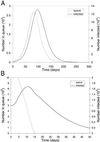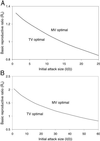Emergency response to a smallpox attack: the case for mass vaccination
- PMID: 12118122
- PMCID: PMC125076
- DOI: 10.1073/pnas.162282799
Emergency response to a smallpox attack: the case for mass vaccination
Abstract
In the event of a smallpox bioterrorist attack in a large U.S. city, the interim response policy is to isolate symptomatic cases, trace and vaccinate their contacts, quarantine febrile contacts, but vaccinate more broadly if the outbreak cannot be contained by these measures. We embed this traced vaccination policy in a smallpox disease transmission model to estimate the number of cases and deaths that would result from an attack in a large urban area. Comparing the results to mass vaccination from the moment an attack is recognized, we find that mass vaccination results in both far fewer deaths and much faster epidemic eradication over a wide range of disease and intervention policy parameters, including those believed most likely, and that mass vaccination similarly outperforms the existing policy of starting with traced vaccination and switching to mass vaccination only if required.
Figures



References
-
- Fenner F., Henderson, D. A., Arita, I., Jezek, Z. & Ladnyi, I. D., (1988) Smallpox and Its Eradication (World Health Organization, Geneva).
-
- Henderson D. A. (1999) Science 283, 1279-1282. - PubMed
-
- Check E. (2001) Nature (London) 414, 677. - PubMed
-
- Centers for Disease Control, (2001) CDC Interim Smallpox Response Plan and Guidelines (Centers for Disease Control, Atlanta, GA), Draft 2.0.
-
- Henderson D. A. (1999) J. Am. Med. Assoc. 281, 2127-2137. - PubMed
Publication types
MeSH terms
Grants and funding
LinkOut - more resources
Full Text Sources
Other Literature Sources
Medical

